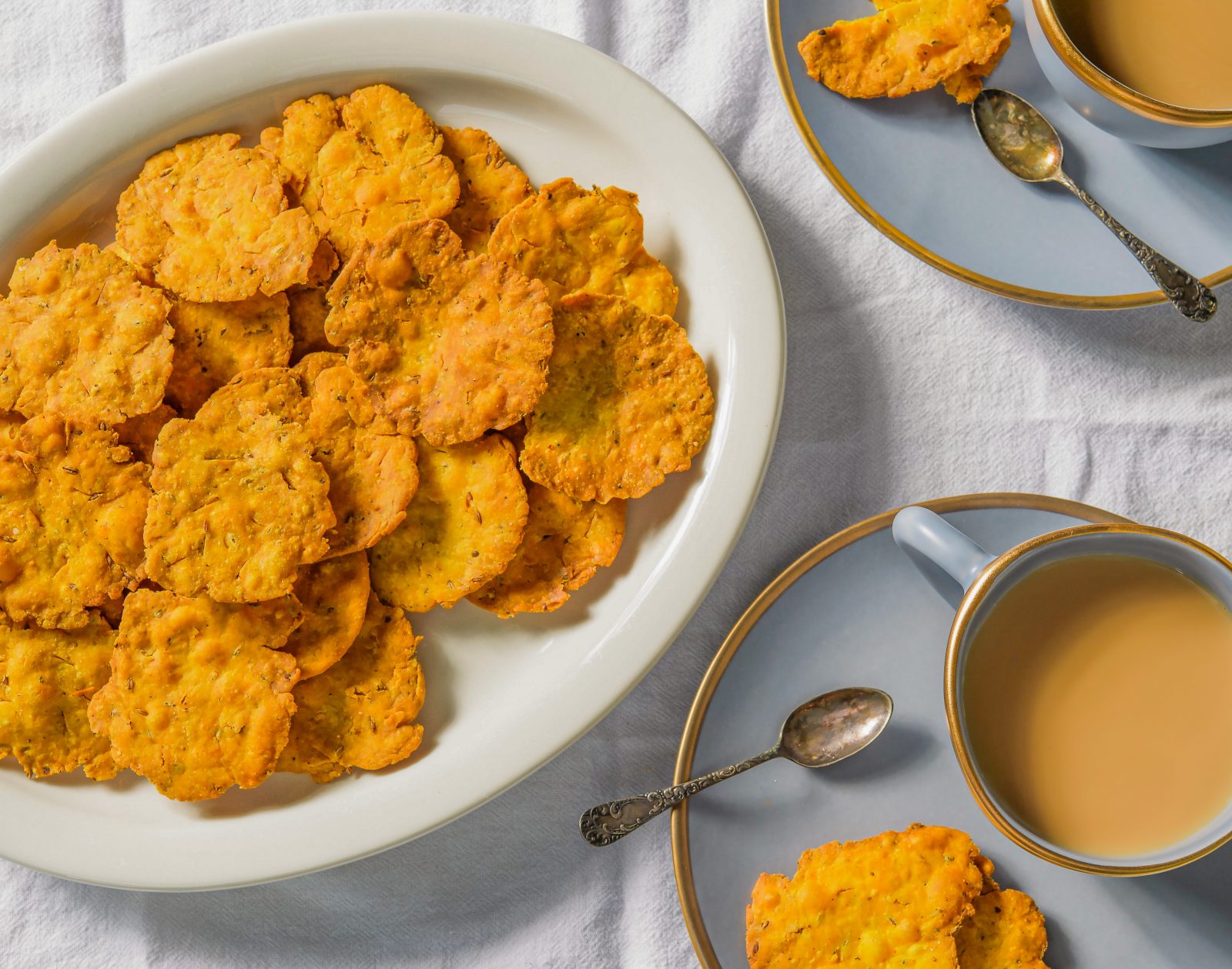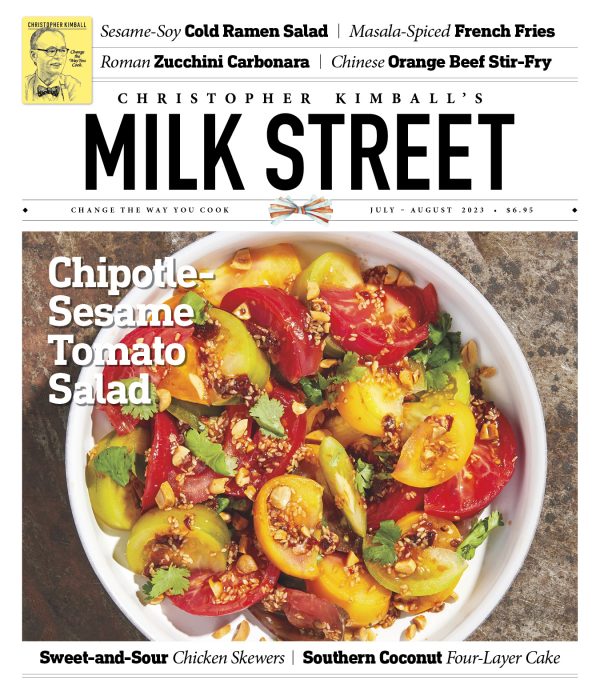Your email address is required to begin the subscription process. We will use it for customer service and other communications from Milk Street. You can unsubscribe from receiving our emails at any time.




Farsi Pooris
This recipe is free for a limited time. 12 WEEKS FOR $1 TO ACCESS EVERY MILK STREET RECIPE. Learn More.
When Sapna Pandya was growing up in Washington, D.C., her paternal grandmother often made a snack that Pandya and her sister called “crunchy pooris.” The round, crisp treats are known as farsi pooris (farsi is Gujarati for “crunchy”). They are popular during Diwali, the festival of lights, when people welcome guests into their homes by offering a variety of homemade snacks. Pandya’s grandmother, Shardaben Natwarlal Pandya, immigrated to the U.S. from Gujarat, on India’s western coast, when Pandya was a year old and lived with her family before moving to an apartment nearby. She recalls “coming home from school to see the kitchen table, counter and floor space all absolutely covered with rolled-out, cumin-accented, flattened pieces of turmeric-colored dough that had been laid out to dry, lovingly and painstakingly pierced all over with my grandmother’s nails.” (Poking holes in the dough, which we accomplish with a table knife, prevents the pooris from puffing up as they fry.) “The whole family would relish the pooris for days, dipping them in chai, eating them while watching cartoons as a treat after finishing our homework, or sometimes as a quick breakfast,” Pandya said. Her grandmother passed away in 2015, at the age of 95. Though Pandya never tried to make crunchy pooris on her own, she is now up to the challenge and would like to pass along the tradition to her daughter, but her grandmother didn’t leave behind a recipe. So Pandya turned to Milk Street for assistance. We researched farsi poori, then developed this recipe. We roll out each portion of spiced dough so the finished snacks have a rustic, homemade look to resemble Pandya’s grandmother’s pooris. For ease, the dough can instead be divided into fourths, rolled about ⅛ inch thick and cut with a 3-inch cookie cutter (the scraps can be rerolled and cut); fry the pooris as directed. The cookie-cutter pooris will be a little thicker and sturdier—but equally delicious. Whichever method you use, be sure to tape a piece of plastic wrap on your counter before kneading and rolling the dough, as the turmeric can stain the counter. To toast the whole cumin and coriander seeds for this recipe, place them in a small saucepan over medium, stirring frequently until fragrant. Let the seeds cool, then grind in a mortar and pestle or spice grinder.
3 dozen
Pooris
1½ hours
1 hour active, plus cooling
-
195
grams (1½ cups) all-purpose flour
-
85
grams (½ cup) semolina flour
-
1
tablespoon cumin seeds, toasted and ground
-
1
tablespoon coriander seeds, toasted and ground
-
2
teaspoons ground turmeric
-
1
teaspoon Kashmiri chili powder or ½ teaspoon cayenne pepper
-
Kosher salt and ground black pepper
-
85
grams (6 tablespoons) ghee, melted and slightly cooled
-
1½
cups grapeseed, peanut or other neutral oil
-
01In a medium bowl, combine both flours, the cumin, coriander, turmeric, chili powder and 1 teaspoon each salt and pepper. Add the ghee and, using your fingers, rub it into the flour mixture until evenly distributed and crumbly like moist sand; the mixture should hold together in your hand when pressed. Add ⅓ cup water, then using your fingers, stir until the flour is evenly moistened and the mixture comes together into a ball; if there are still dry bits, stir in 1 to 2 tablespoons more water.
-
02Using masking tape, attach a 12-inch square of plastic wrap to the counter to protect it from turmeric stains. Turn the dough out onto the plastic wrap and knead until a smooth, cohesive dough forms, about 2 minutes. Form the dough into a ball, wrap in plastic wrap and let rest at room temperature for at least 30 minutes or up to 3 hours. Keep the plastic wrap taped to the counter for rolling out the dough.
-
03Line a baking sheet with paper towels. Divide the dough into about 36 portions (about 1 rounded teaspoon each), then form each portion into a ball, setting them on a large plate; cover with plastic wrap. Set 1 dough ball in the center of the plastic wrap taped to the counter; keep the rest covered. Using your hand, flatten the ball, then use a rolling pin to roll it into a 2½- to 3-inch round about ⅛ inch thick. Use the tip of a table knife to cut 8 to 10 slits in the round, piercing all the way through the dough. Place the round on the prepared baking sheet; do not cover. Repeat with the remaining dough balls, overlapping the rounds as needed to fit. (The rounds can be fried right away or kept uncovered at room temperature for up to 30 minutes before frying. Allowing them to dry before cooking results in a slightly flakier finished texture.)
-
04Set a wire rack in a rimmed baking sheet. In a 12-inch skillet over medium, heat the oil to 350°F. Slip 5 or 6 rounds into the oil and fry, flipping 2 or 3 times, until bubbled all over and golden brown, 1½ to 2 minutes; adjust the heat as needed to maintain an oil temperature of 325°F to 350°F. Transfer to the prepared rack. Fry the remaining rounds in the same way. Let cool for at least 10 minutes to allow the pooris to crisp. Serve warm or at room temperature.






